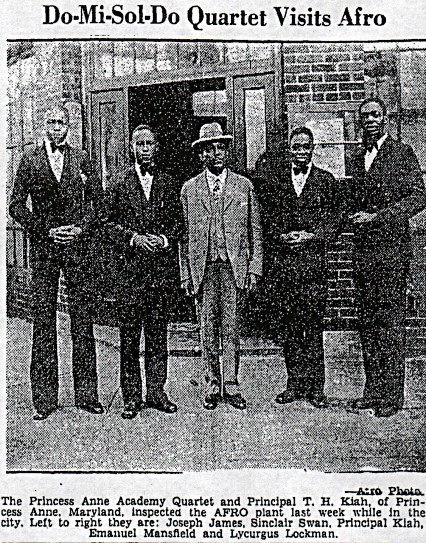Music has deep roots at UMES. From the donation of 15 instruments in 1902 that constituted the beginning of the Coronet Band to Clarence Clemons belting out saxophone riffs on stage alongside rock ‘n’ roll star Bruce Springsteen, the campus at Princess Anne has been the home of aspiring and occasionally legendary musicians.

Nearly lost to the passage of time and the ephemeral nature of popular music is the Princess Anne Quartet and perhaps its most musically accomplished member, Emanuel Mansfield.
The 1920s witnessed a renaissance in traditional African American spirituals. Daniel Lyman Ridout Sr. (alumnus, author of the alma mater and director of music at Princess Anne Academy), took note of the trend in 1926 when he wrote:
“A few years ago, even in the writer’s knowledge, the average Negro above the Mason-Dixon Line did not like Negro spirituals. They seemed to suggest unpleasant memories of slave days. But the fact was we knew too little about them. Fortunately, we have learned to look deeper into that meaning, and as a result, everybody wants to hear the Negro Spiritual of today. They have slowly but surely come into their own.”
It is no surprise that by that date, the Princess Anne Academy Quartet, under Ridout’s direction, found success singing spirituals and other works in venues across the Eastern Shore, Pennsylvania and New York as well as on radio stations in Atlantic City, N.J., New York and Philadelphia. This regional exposure brought not only prestige to tiny Princess Anne Academy, but since performances were often given to benefit the institution’s “School Fund,” the quartet also acted as a fund-raiser.
One incarnation of the Quartet under Ridout’s direction included Cyrus Derrickson, William Pitts, Sinclair Swan and Brewington Kiah, the son of academy Principal Thomas H. Kiah.
While Ridout and the quartet toured, a young tenor was gaining attention in Philadelphia. Singing in the choir of the famed First African Baptist Church while attending Lessie Spurlock’s School of Music, Emanuel Mansfield was instantly popular in church music circles. A little more than a year after his initial recital in March 1926, Mansfield found himself on a well-received singing tour of Virginia billed as the “famous tenor of Philadelphia.”
It is uncertain how Mansfield came to Princess Anne Academy on scholarship in 1927, but it is not unreasonable to imagine Ridout, whose finger was on the pulse of spiritual music in the region, may have had a hand in the recruitment. At the Academy, Mansfield met Swan (second tenor), Joseph James (baritone) and Lycurgus Lockman (bass). Together, the four formed the most famous version of the Princess Anne Quartet.
From 1927 until late 1929, the Quartet, with Mansfield in the lead, toured up and down the East Coast, performing for large audiences and radio stations in major markets. Each singer was in a different class, so graduation threatened to stall the group’s momentum. The decision was made to leave Princess Anne and continue studies at Claflin College, a private Methodist school in Orangeburg, S.C.
In an age when singers were treated like today’s college athletes, the move lead one newspaper to report: “if it could be proved that Claflin stole this group, it must be granted that Claflin knew what and when to steal.”
An Oct. 26, 1929 article in the New York Age newspaper under the byline of “M.F. Pinkett,” likely Princess Anne Academy instructor Maslin Frysinger Pinkett, informed readers that “Claflin … is reported to have offered them such fine inducements that they have moved as a unit to the Southern school, where they were received with much appreciation.”
Mansfield and company toured under the name and colors of Claflin for the next two years before moving on to the Boston Conservatory of Music to continue their education as a group. In New England, they adopted the name “Mansfield Singers.” With the namesake in the lead and Sinclair Swan as business manager, they embarked on a four-year tour. The quartet formed at the small school on the Eastern Shore performed across the United States, in Canada as well as in Japan, Korea, China and the Philippines.
The pursuit of education finally split the group, but each continued to pursue individual musical interests.
Swan enrolled in Hampton University in 1935 and eventually taught music and English at the high school level in the Baltimore area. Lockman stayed in the Boston area, formed the “Southland Singers,” and engaged in radio work before appearing in an early production of “Porgy and Bess.” James also appeared on Broadway and toured in a production “Porgy and Bess” following World War II, when he worked as a welder in a California shipyard and became well-known organized-labor activist.
Mansfield continued performing across the country for the next 30 years. Although widely considered as “unexcelled in his interpretation of Negro spirituals,” he would often show his range by performing classics, such as Verdi’s “Il balen del suo sorriso,” in its original Italian.

